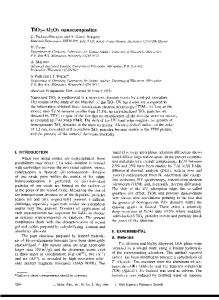Immobilization of Fe 2 O 3 /TiO 2 photocatalyst on the metallic substrate via plasma electrolytic oxidation process: deg
- PDF / 3,377,772 Bytes
- 13 Pages / 547.087 x 737.008 pts Page_size
- 67 Downloads / 301 Views
RESEARCH PAPER
Immobilization of Fe2O3/TiO2 photocatalyst on the metallic substrate via plasma electrolytic oxidation process: degradation efficiency Amin Hoseini & Benyamin Yarmand
Received: 30 March 2020 / Accepted: 8 October 2020 # Springer Nature B.V. 2020
Abstract This study aimed to extend the application of plasma electrolytic oxidation (PEO) process to the production of immobilized composite photocatalysts with sensitizing nanoparticles (NPs) on the metallic substrate. For this purpose, the immobilized Fe2O3/TiO2 layers with different amounts of sonochemically synthesized Fe2O3 NPs were prepared on the titanium substrate using the PEO method and their structural, morphological, optical, and photocatalytic properties were investigated. The results showed that the immobilized Fe2O3/TiO2 layers with pancake-like morphology were homogeneously formed and the Fe2O3 NPs were uniformly embedded. The participation of the Fe2O3 NPs in layer formation events resulted in the phase transformation of anatase to rutile and an increase in the number of small surface pores. With the increment in the amount of incorporated Fe2O3 NPs, the absorption band-edge of immobilized layers shifted to the longer wavelengths and their light utilization from the visible region of the solar radiation spectrum considerably increased. As a result of these changes, the degradation efficiency of methylene blue aqueous solution under ultraviolet irradiation significantly enhanced with adding 3 g.L−1 Fe2O3 NPs to the phosphate-based electrolyte. Keywords Immobilization . Fe2O3/TiO2 . Photocatalyst . Plasma electrolytic oxidation . Degradation efficiency . Nanostructured catalysts A. Hoseini : B. Yarmand (*) Nanotechnology and Advanced Materials Department, Materials and Energy Research Center (MERC), Karaj, Iran e-mail: [email protected]
Introduction Destroying organic pollutants found in industrial wastewater using photocatalytic processes is a valuable strategy to protect water resources, and many efforts have already been made to apply it (Abdullah et al. 2017; You et al. 2019). Given their high activity, good stability, non-toxicity, easy and inexpensive synthesis, titanium oxide (TiO2) photocatalysts are a good option for water purification systems. The inherent disadvantages of TiO2 photocatalysts include their low visible light absorption and rapid photogenerated charge carrier recombination which undermine their photocatalytic efficiency (Ani et al. 2018; Zhang et al. 2014a; Zhu and Gao 2014). Sensitization of TiO2 using compounds with high visible light absorption such as transition metal oxide semiconductors is a good solution for enhancing photocatalytic performance. Various studies have shown that coupling iron oxide (Fe2O3) semiconductors with TiO2 has a significant effect on degradation reactions in the photocatalytic system. Besides, Fe2O3 has many advantages such as being abundant, environmentally compatible, and low cost (Baniamerian et al. 2020; Hitam and Jalil 2020; Palanisamy et al. 2013; Rao et al. 2017). The use of p
Data Loading...











